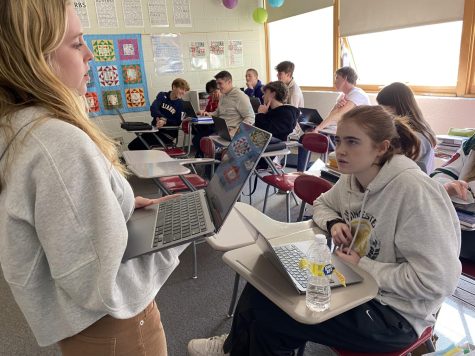Inside the Knight Errant
In the halls of Benilde-St. Margarets, 52 hard-working students rush in and out of the classroom. Their minds are set on one task: finding the perfect story. From interviews, to writing, to editing, these students explore what it means to be journalists in their own community.
The Knight Errant has various tiers of responsibilities. First semester students are staff writers, second semester students are varsity writers, and some more experienced writers become editors or even Editors-in-Chief (EICs).
The work for varsity writers and writers are exactly the same; varsity writers just have more experience. The process of writing starts with finding something you are passionate about or something you want to learn more about and pitching the idea to your editor. You must then find an appropriate angle to approach the story and depending on that angle, find people that you know will contribute to the story and interview them.
Stories in the News, Student Life, Features, and Sports sections are interview based. This means the interview will pretty much lead your writing. Most of the workload can be accomplished in class, but sometimes a little work will carry over at home. “You do have to do some work outside of class like emailing teachers or actually writing the article because a lot of the time when you’re in class, you’re doing the interviews and gaining the material you need to actually write the story,” varsity writer Olivia Gorton said.

After a semester or two of getting the feel of the class, writers can move to the editing process. As editors, they still get to write but they also have additional responsibilities. Each editor is assigned to a group of writers that they will be most often collaborating with. In these groups, their jobs are to help keep their writers on track and make sure that the writing is up to the required standards. With the responsibilities of both a writer and an editor, it can seem quite daunting at times, especially for the new editors.
“As an editor, I spent a lot of time obviously going through with edits on my writer’s stories. And I think I found that balancing my own writing with editing has been challenging and I feel like I’m just kind of getting into a groove with it,” editor Emily Walsh said.
EICs are a few select second year editors that are chosen to be in a leadership position. EICs, though similar to editors, don’t focus as much on one specific group of writers. The responsibilities expand more towards publication of the stories, and looking over what the editors have already looked at.
“I think as an Editor-in-Chief, you just have more responsibility over the paper as a whole whereas as an editor, your responsibilities are more concentrated towards just your writers…there’s also just more decisions about goals and changes that we have from the newspaper that we have more control over as Editors in Chief,” Editor-In-Chief Megan Cornell said.
The Knight Errant differs from other electives in many ways. For one, the course is very student led. After the first few weeks of school, the role the teacher plays in the classroom is mostly supervision. They stay within the realm of checking in with students and answering questions.“It’s very little of me in front of the classroom outside the first couple of weeks when we’re talking about basic knowledge of the class and how to write and how to edit for my new editors,” journalism teacher Tiffany Joseph said.
Most staff members would agree that one of the most beneficial aspects of this course is that it is a collaborative environment. Everyone works with everyone, and people aren’t separated by things like grade level. “Everyone always gets really close, and I feel like I meet new people through journalism. Last year specifically, our editorial board became really close.…We would hang out outside of school all the time and I’m still close to them now even though they’re in college,” Cornell said.
Another example of how this course contrasts from others is the work environment. It is a lot more freeform, and you have a lot of time to work on whatever stage of your current story you are on, whether it be interviews, or talking to editors. You also have a lot more control over what you are writing about, so you get to write about what you are interested in and have fun with. “I’d say my favorite part is that when you’re writing all these different articles, you can do so many different topics. You don’t have to write about one certain thing. Or one certain genre. There’s actually a lot of different types of writing that you can do and you can base it off of what you like to do,” Gorton said.






































![Teacher Lore: Mr. Hillman [Podcast]](https://bsmknighterrant.org/wp-content/uploads/2025/03/teacherlorelogo-1200x685.png)




Xander • Nov 11, 2022 at 10:11 pm
Beautiful video composed by none other than Samuel Peters. Well done young man